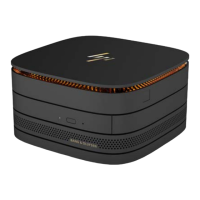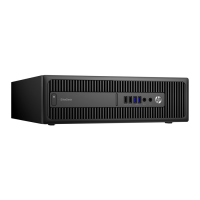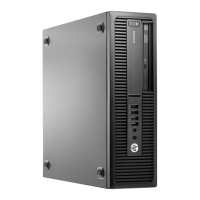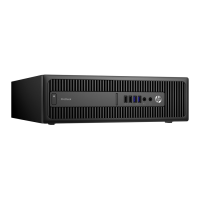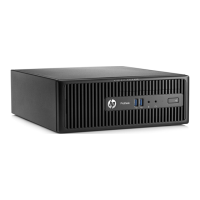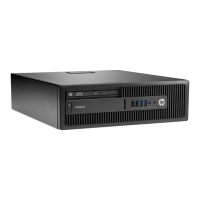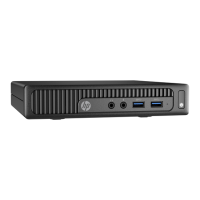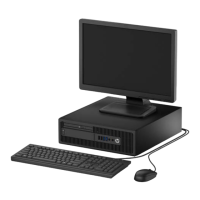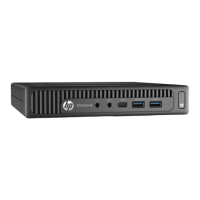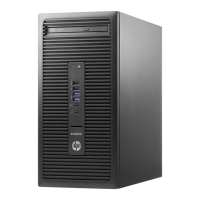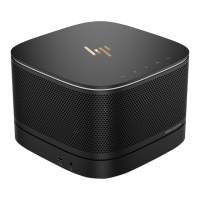
Do you have a question about the HP Elite Slice G2 and is the answer not in the manual?
| Bus type | DMI3 |
|---|---|
| Processor cache | 6 MB |
| Processor model | i5-7500T |
| Processor threads | 4 |
| Processor frequency | 2.7 GHz |
| Processor cache type | L3 |
| Processor manufacturer | Intel |
| Processor boost frequency | 3.3 GHz |
| Number of processors installed | 1 |
| Configurable TDP-down frequency | 1.7 GHz |
| ECC | No |
| Internal memory | 8 GB |
| Memory clock speed | 2400 MHz |
| Internal memory type | DDR4-SDRAM |
| Maximum internal memory | - GB |
| Memory layout (slots x size) | 2 x 4 GB |
| SSD capacity | The Solid State Drive's storage capacity in Gigabytes. |
| SSD interface | NVMe |
| Storage media | SSD |
| SSD form factor | M.2 |
| Total storage capacity | 128 GB |
| Intel Identity Protection Technology version | 1.00 |
| Sustainability certificates | ENERGY STAR |
| Discrete graphics card model | Not available |
| On-board graphics card model | Intel® HD Graphics 630 |
| Maximum on-board graphics card memory | 64 GB |
| Antenna type | 2x2 |
| Bluetooth version | 4.2 |
| Top Wi-Fi standard | Wi-Fi 5 (802.11ac) |
| WLAN controller model | Intel Dual Band Wireless-AC 8260 |
| Ethernet LAN data rates | 10, 100, 1000 Mbit/s |
| USB 2.0 ports quantity | 0 |
| USB 3.2 Gen 1 (3.1 Gen 1) Type-A ports quantity | 2 |
| Chassis type | USFF |
| Product color | Black |
| Country of origin | China |
| Audio chip | Conexant CX7501 |
| Product type | PC |
| Motherboard chipset | Intel® Q170 |
| Operating system installed | Windows 10 IoT Enterprise |
| HP segment | Business |
| Power supply | 90 W |
| Width | 165 mm |
|---|---|
| Height | 112 mm |
| Weight | 1520 g |
| Package depth | 596 mm |
| Package width | 203 mm |
| Package height | 273 mm |
| Package weight | 6670 g |
Overview of the Elite Slice G2's audio and conferencing capabilities.
Identifies and describes the capacitive touch buttons on the Elite Slice G2.
Details the ports and connectors located on the rear of the Elite Slice G2.
Lists and describes the ports on the sides of the Elite Slice G2.
Describes the Video Ingest Module for Microsoft SRS and its limitations.
Details the optional Wireless Display Module for signal transmission to a transceiver.
Explains the optional ODD Module for adding optical drive functionality.
Describes the optional VESA plate for mounting the Elite Slice G2.
Outlines the order of connecting additional modules to the Base Module.
Provides step-by-step instructions for safely removing connected modules.
Details how to connect the HP Cable and Port Cover for power supply.
Explains where to find serial and product ID numbers for support.
Identifies key internal components of the HP Elite Slice G2, including fan sink and speaker.
Lists the HP Cable and Port Cover as a component, not illustrated.
Provides a table of country-specific codes for keyboards.
Lists the various modules available for the HP Elite Slice G2.
Details the specifications for memory modules and the types of Intel Core processors.
Lists available adapters for connecting different types of displays and peripherals.
Lists available M.2 and 2.5-inch solid-state drives with their capacities.
Explains the risks of ESD and how it can damage components.
Provides precautions to prevent ESD damage to electronic components and accessories.
Details equipment like wrist straps and heel straps for preventing static electricity.
Outlines precautions for creating a safe, static-dissipative work environment.
Lists recommended grounding equipment to prevent electrostatic damage.
Provides guidelines to prevent overheating and prolong the computer's life.
General procedures for cleaning the computer's external components.
Lists essential safety precautions to follow before cleaning any computer component.
Provides step-by-step instructions for cleaning the exterior of the computer case.
Details procedures for cleaning the keyboard, including under the keys.
Explains how to clean the monitor screen and body safely.
Provides instructions for cleaning the mouse, including the ball and internal components.
Lists important considerations before disassembling or assembling the computer.
Lists the necessary tools and diagnostic software for computer servicing.
Advises on screw types and the importance of keeping them organized during disassembly.
Discusses the computer's coin cell battery, its function, and safety warnings.
Details how to remove and replace the access panel to reach internal components.
Covers memory module types, installation, and capacity, including dual-channel benefits.
Lists the required specifications for SODIMMs to ensure proper system operation.
Explains how memory modules are installed in slots and how the system operates in different modes.
Provides step-by-step instructions for installing new memory modules into the computer.
Details the process for removing and installing 2.5-inch SSDs, including the drive cage.
Provides instructions for removing and replacing the computer's internal speaker.
Outlines the procedure for removing the Base Module from the Audio Module.
Details how to remove and replace the WLAN module, including antenna connections.
Explains the RTC battery's role and provides instructions for its replacement.
Describes how to remove and replace the ambient sensor located on the system board.
Provides steps for removing and replacing the fan sink, including thermal grease precautions.
Details the procedure for removing and installing M.2 PCIe SSDs.
Provides detailed instructions for removing and installing the CPU, emphasizing pin handling.
Outlines the comprehensive steps for removing the system board, including disconnecting components.
Explains how to reprogram SMBIOS information after system board replacement using Computer Setup.
Details the fields and their purpose within the System ID setup page in BIOS.
Identifies front-side components and their labels on the system board.
Identifies rear-side components and their labels on the system board.
Lists the various functions that can be performed using the Computer Setup utility.
Explains how to access and navigate the Computer Setup Utilities menu.
Describes options within the Main menu, including system information and diagnostics.
Details how to update the system BIOS using various sources like HP.com or USB.
Explains how to adjust system date and time settings.
Covers setting asset tracking numbers and ownership tags.
Describes backing up and restoring system configuration settings to a USB device.
Explains how to save current system configuration settings as custom defaults.
Applies custom default settings after rebooting.
Restores factory system configuration settings after rebooting.
Exits Computer Setup without saving any changes.
Saves changes to system configuration and exits Computer Setup.
Details security options like BIOS administrator and power-on passwords, and TPM settings.
Explains BIOS Sure Start features like verifying boot blocks and data recovery policies.
Covers enabling TXT and its prerequisites.
Explains DriveLock and Secure Erase features for hard drive security.
Allows authorized personnel to reset security settings.
Resets security devices and BIOS passwords to factory defaults.
Covers advanced settings for display language, power-on, boot options, and UEFI/legacy boot order.
Explains Legacy Support and Secure Boot settings, including key management.
Covers processor features like Turbo-boost, Hyperthreading, Virtualization Technology, WLAN/BT, and SSD settings.
Manages settings for integrated devices like LAN Controller, Wake On LAN, Video Memory, USB/Bluetooth, and Audio.
Allows hiding specific ports from the OS, USB Legacy Port Charging, and USB Type-C charging.
Specifies which categories of USB devices are enabled.
Prevents BIOS from updating Type-C controller firmware.
Controls loading of Legacy Option ROMs or UEFI drivers.
Manages Runtime Power Management and Extended Idle Power States.
Reduces system power in the S5 (off) state.
Enables/disables SATA bus and device power management.
Allows PCI Express links to use low power states.
Enables keyboard key presses to power on the system.
Provides visual indication of sleep states via LED blink patterns.
Covers Active Management (AMT), USB provisioning/redirection, SOL emulation, and watchdog timers.
Explains how to save and restore computer configuration settings using the F10 utility.
Guidelines for creating a safe and comfortable work environment.
Essential checks and steps to perform before contacting technical support.
General suggestions to resolve computer, monitor, or software issues.
Addresses common issues like system lock-ups, incorrect date/time, no sound, and poor performance.
Common causes and solutions for computer power-related issues.
Troubleshooting steps for sound issues like cuts, low volume, or no sound.
Addresses issues with keyboard input, mouse movement, and connectivity.
Resolves issues when adding or removing hardware and device recognition.
Troubleshoots network connectivity issues, driver problems, and status lights.
Addresses issues related to memory installation, count errors, and system boot failures.
Troubleshoots issues with USB flash drives not being recognized or not booting.
Guides on resolving internet connectivity issues, browser setup, and ISP problems.
Addresses common software issues, application errors, and driver conflicts.
Lists POST errors with numeric codes and text messages, and recommended actions.
Explains how to interpret patterns of blinking LEDs and beeps during system startup.
Provides steps to clear system passwords by manipulating the password jumper.
Explains how to reset BIOS settings to default using the CMOS button.
Details how to use the Windows-based utility for hardware diagnostics.
Instructions for downloading the diagnostic tool from HP support websites.
Steps to install the downloaded diagnostic software on the computer.
Explains how to use the UEFI version for diagnosing hardware issues outside the OS.
Guides on initiating diagnostic tests from the UEFI environment.
Instructions for creating bootable USB media for UEFI diagnostics.
How to download UEFI diagnostics using product name or number.
Explains remote diagnostics execution and results upload.
Instructions for downloading remote diagnostic tools.
Steps to get the most recent version of remote UEFI diagnostics.
How to download remote UEFI diagnostics using product identifiers.
Guides on configuring unattended diagnostics and result storage.
Explains using Windows built-in tools for backup, restore points, and recovery media.
Guides on using HP Recovery Manager to create bootable recovery media.
Provides steps for creating recovery media using HP Recovery Manager.
Instructions for creating recovery media using the HP Cloud Recovery tool.
Overview of options for restoring, resetting, and refreshing the computer.
Details Windows options for restoring, resetting, and refreshing the system.
Explains restoring the computer to factory state using HP Recovery Manager or partition.
Steps to recover the computer to factory state using HP Recovery Manager software.
How to perform system recovery using the HP Recovery partition.
Steps to recover the system using HP Recovery media.
Explains how to modify the boot order in BIOS to select startup devices.
Instructions for removing the recovery partition to free up hard drive space.
Lists requirements for power cords applicable to all countries, including agency approval and wire specs.
Details country-specific requirements for power cord sets and fittings.
Describes types of nonvolatile memory, their purpose, and how data is stored/protected.
Provides steps to restore nonvolatile memory, potentially clearing personal data.
Explains how to reset BIOS settings to factory defaults.
Defines UEFI BIOS and its differences from legacy BIOS.
Explains that UEFI BIOS resides on a flash memory chip.
Details the type of configuration data stored on the DIMM Serial Presence Detect (SPD) module.
Clarifies that this refers to clearing RTC CMOS memory containing configuration data.
Explains how to reset BIOS security to factory defaults and erase data.
Steps to clear Custom Secure Boot Keys, separate from BIOS security reset.
Information on HP Sure Start technology for BIOS monitoring and restoration.
Provides the physical dimensions of the computer in both U.S. and metric units.
States the approximate weight of the computer.
Details the operating and non-operating temperature limits for the computer.
Specifies the operating and non-operating relative humidity levels.
Lists the maximum operating and non-operating altitudes.
Details the power supply's operating voltage range, rated voltage, and line frequency.
